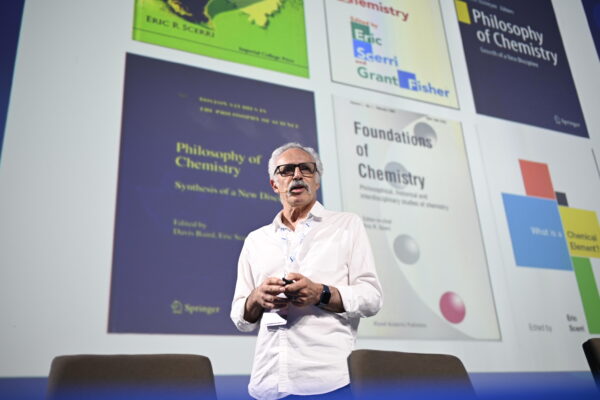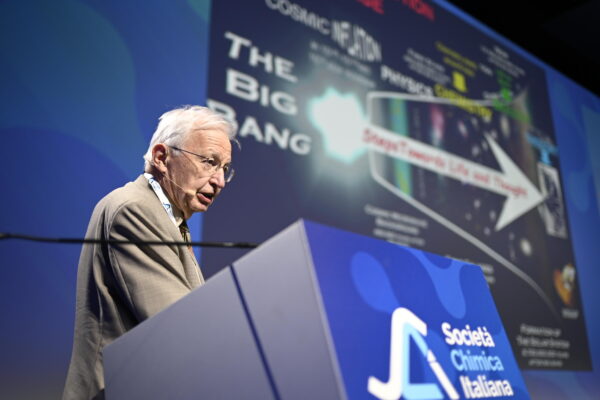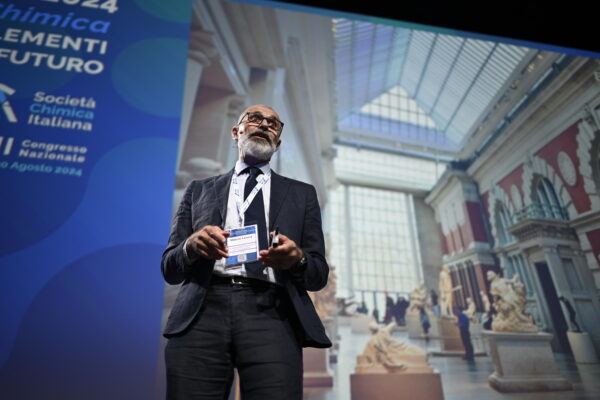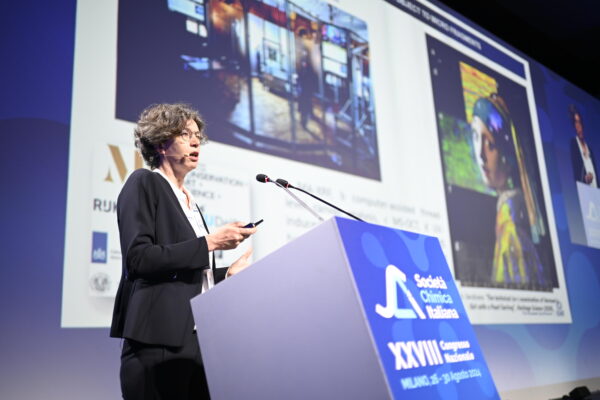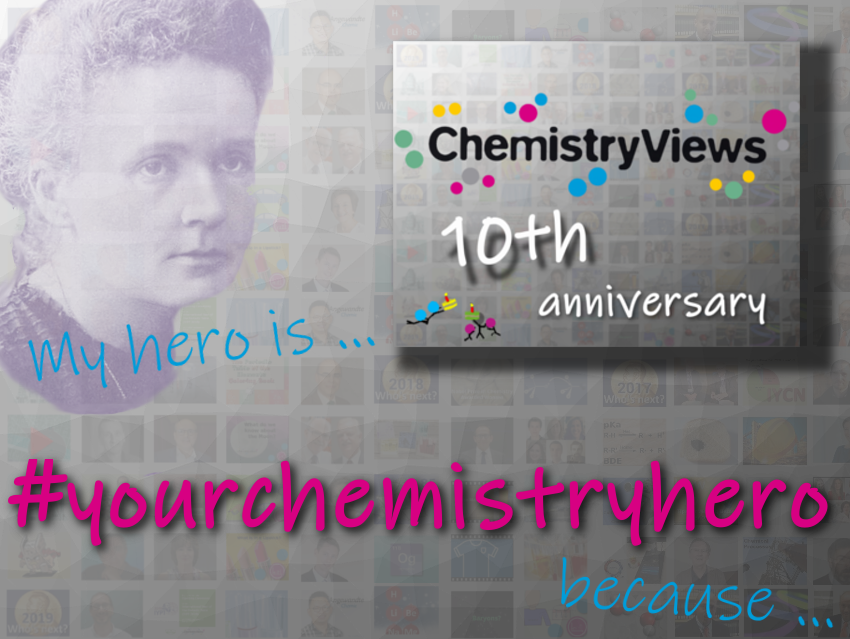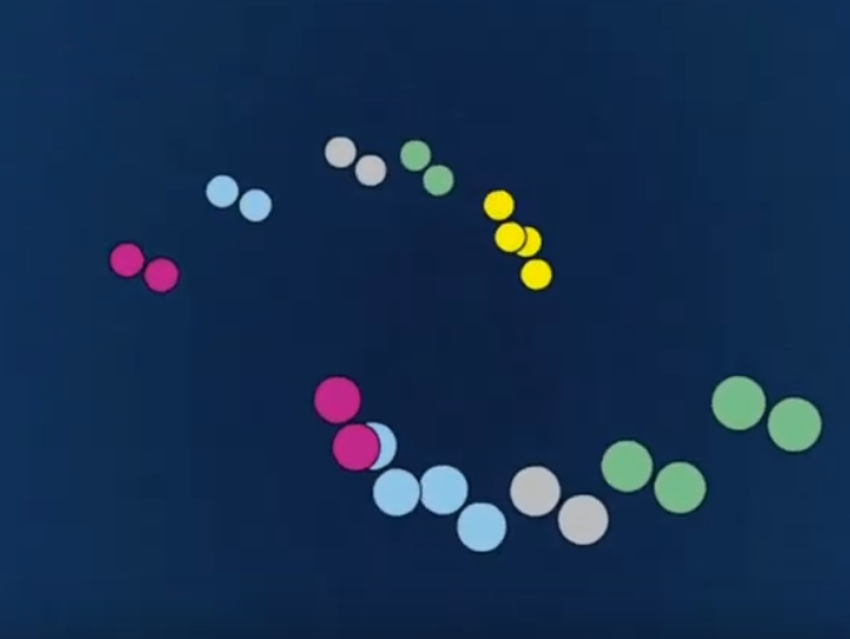1 Innovating, Engaging the Youth, Bridging Disciplines
The 28th National Conference of the Società chimica italiana (Italian Chemical Society-SCI) took place this year at the Allianz MiCo • Milano Convention Centre with over 2,400 participants. Not only was the attendance amazing—much higher than at the EuChemS meetings—but the program and organization were also outstanding.
The conference began with a spectacular kickoff, setting the tone for a vast and diverse event. We entered a lecture hall bathed in blue light and a grand conference emblem displayed on the stage. A video introducing SCI and its mission and work was followed by the ceremonial entry of the speakers of the Opening Ceremony. Notably, the first speeches given were dedicated to the next generation of chemistry, with talks by Marta Da Pian, head of the SCI Junior group, Maria Sole Fiorino, bronze winner at the International Chemistry Olympiad (IChO 2024), and Federico Berretta, a Ph.D. student at the Sapienza University of Rome.
Angela Agostiano, President of EuChemS, and Gianluca Farinola, President of SCI, delivered their welcome speeches thereafter. They all emphasized the importance of giving the next generation a voice and highlighted the crucial role of innovation and youth engagement in driving scientific progress.
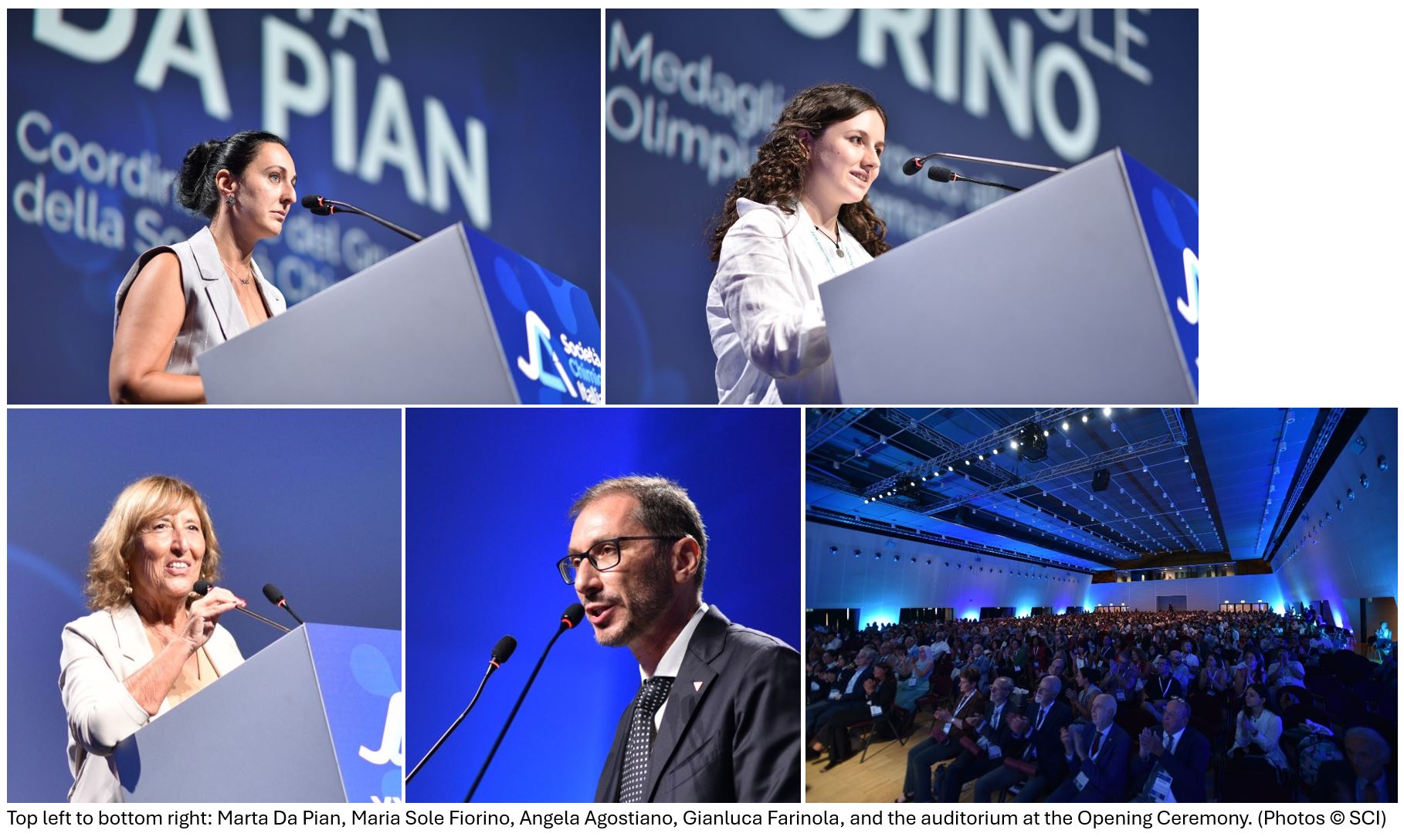
In his opening speech, President Gianluca Farinola emphasized the central role of chemistry in addressing global challenges and called on the chemical community to take further steps in its service towards the construction of a sustainable future. He mentioned that chemists bring more than powerful scientific and technological tools; they bring a unique and valuable intellectual approach, stemming from their ability to look beyond the visible and to critically analyze the reality. He also highlighted one of the most important messages of this conference: the duty of the scientific and professional community of chemists to communicate their approach and their content beyond their borders, bringing their voice in those contexts where political, societal, and economic decisions relevant to the future are made.
The conference motto, “Elementi di Futuro” (Elements of the Future), emphasized a focus on the fundamental components and ideas that will shape the future. The topics spanned a broad spectrum, from organic and inorganic chemistry to food chemistry, medicinal chemistry, and chemical engineering. In addition to these scientific fields, the conference highlighted innovative concepts and interdisciplinary approaches with other disciplines as essential building blocks for future progress. Presentations and discussions also addressed cultural heritage, equality, and the intersections of chemistry with music, film, and visual arts.
“Instead of organizing discussions by traditional chemical disciplines like organic or inorganic chemistry, the focus was on major challenges that require interdisciplinary approaches. These included topics like advanced imaging, health, sustainable production, and food, as well as broader issues like inclusion, gender equality in chemistry, and science communication.”, Gianluca Farinola said.
🎵 Exploring Science Through MusicHow Music Alters PerceptionThe SCI invited young Italian musicians to compose a 6-minute soundtrack for a scientific film illustrating various chemical phenomena. A jury selected five finalists who presented their work at the conference. Congress attendees voted for their favorite soundtracks, with three winners receiving plaques, certificates, and cash prizes. The idea of the competition was to explore a new perspective on the molecular world. It was amazing how the same video seemed different each time it was paired with different music, revealing new aspects with each variation. The competition was organized by the SCI and the Istituto Lombardo Accademia di Scienze e Lettere, conceived by Luisa De Cola, Professor at the University of Milan, with musical advice from Daniela Uccello, soprano at the Casa della Musica e delle Arti, Italy, and film director Francesco Leprino, director at Al Gran Sole, Italy.
What to Learn from Jazz Improvisation?Marco Pignataro, Managing Director of the Berklee Global Jazz Institute (BGJI), Boston, MA, USA, and Fiorenzo Omenetto, Professor of Biomedical Engineering at Tufts University, MA, USA, explored the parallels between scientific research and jazz improvisation, allowing the audience to experience this connection through saxophone music. They emphasized that changing one element in science works much like in music—both involve processes of discovery and innovation. Through their collaborations, they have found that connecting different worlds leads to surprising insights and connections. In their view, interdisciplinarity is not just about combining disciplines but about being comfortable with the unknown, open to new experiences, and driven by passion and a willingness to work together. They also addressed the question: What do we do with the knowledge we produce as scientists? Together, they build bridges to communicate science to the public, stressing the importance of clear and inclusive communication. We often live in bubbles where communication is easy within, but we forget others outside them. They believe the humanities should re-enter the realm of science communication, and that scientists must engage in discussions with ethicists and philosophers. After all, people have always been eager to explore and understand the world around them and science is at the center here and has lots to offer.
Luisa De Cola summarized these two music sessions, “The SCI congress has been a highly multidisciplinary meeting, breaking boundaries not only between different scientific fields but also by integrating art and music. The final afternoon demonstrated how art, music, and science share qualities like curiosity, creativity, discipline, perseverance, and, ultimately, enthusiasm—exemplified by musician Marco Pignataro, who engaged the entire audience in singing. The meeting concluded by focusing on the next generation of composers, who competed to create a soundtrack for a scientific movie. This experiment of giving life and sound to a series of chemical events added a powerful emotional dimension to the already exciting journey from simple molecules to life.” |
2 Posters, Exhibition
In addition to the lecture program, there were more than 1,000 posters and a large exhibition area. Besides various company presentations, including those from Shimadzu and others, the Polizia Scientifica (Forensic Police) showcased scientific analysis methods used in forensic science, such as fingerprint visibility techniques, at their booth. Chemistry Europe hosted a quiz at their booth, focusing on their connection with the SCI and Italy.
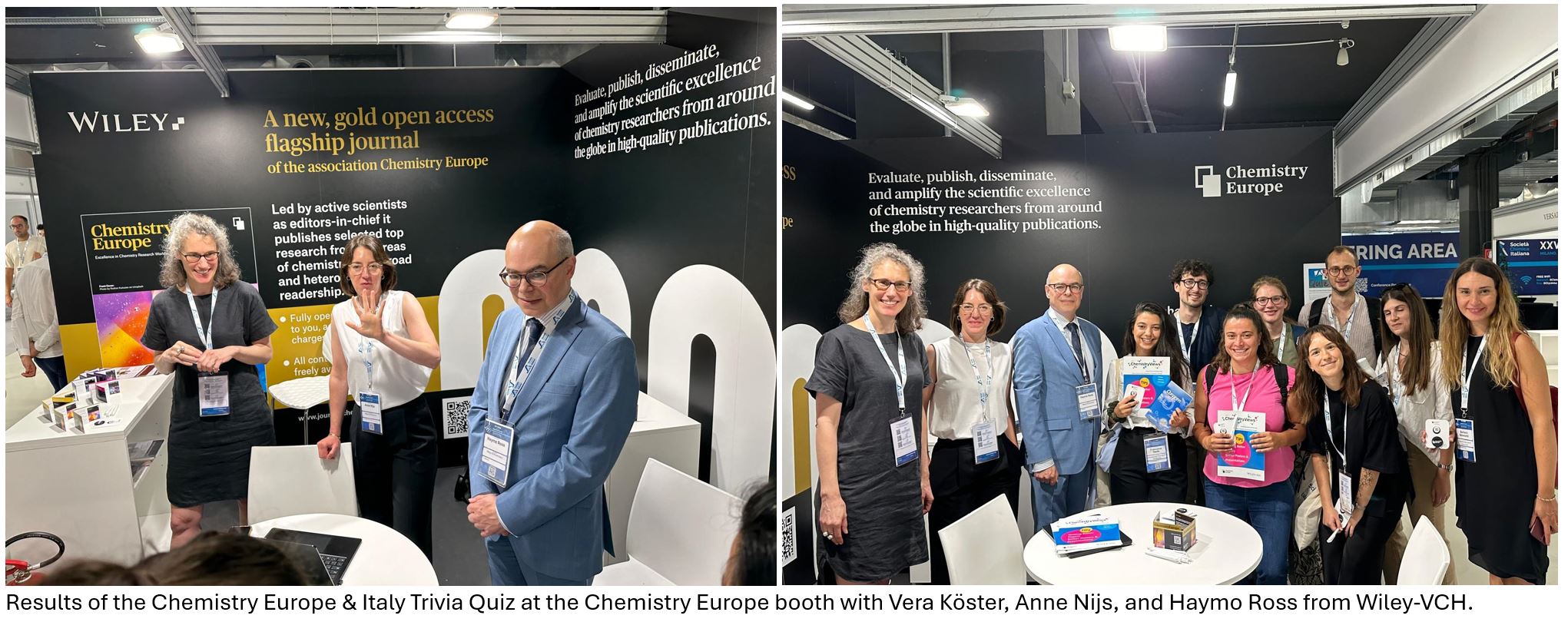
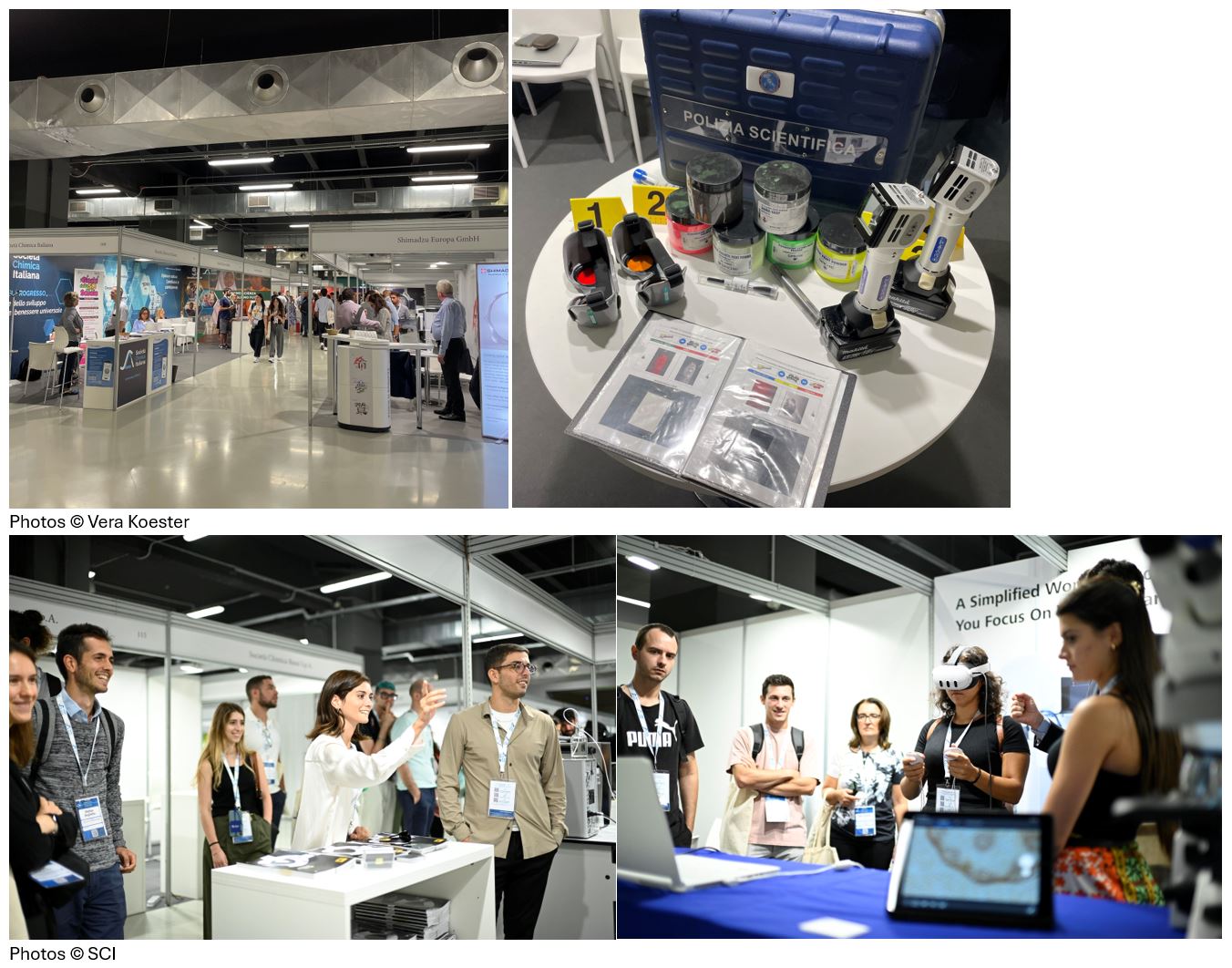
🎤 Exploring Science Through Performing ArtsTransforming the Image of Chemists in CinemaClaudio Pettinari, Professor of General and Inorganic Chemistry at the University of Camerino (UNICAM) described the often negative portrayal of chemistry in films. If at all, chemistry is depicted as either harmful, such as in the production of drugs or environmental disasters, or as the realm of eccentric, nerdy, and unrealistic scientists. Claudio Pettinari advocates for a change in how chemistry is portrayed, aiming to better reflect its role in providing solutions and driving progress. He suggests presenting this new perspective not only to TV audiences but also on big screens. He thinks that public engagement and innovative teaching methods are essential in changing the perceptions.
From Quantum Physicist to Actress and Author
Originally trained as a physicist, Gabriella Greison worked at the École Polytechnique in Paris before beginning to present numerous popular science programs for radio and television. She has been involved for years with theaters across Italy, showcasing her science-themed performances aimed at the general public. She also works as an author and has published, for example, L’incredibile cena dei fisici quantistici (The Incredible Dinner of the Quantum Physicists, 2016), Storie e vite di superdonne che hanno fatto la scienza (Stories and lives of Superwomen who made science, 2017), wonderfully illustrated by twenty internationally renowned artists, Hotel Copenaghen (Hotel Copenaghen, 2018), Einstein e io (Einstein and me, 2018), La leggendaria storia di Heisenberg e dei fisici di Farm Hall (The Legendary Story of Heisenberg and the Farm Hall Physicists, 2019). |
3 Awards and Recognitions
During the conference, awards were presented, and exceptional members were celebrated for their contributions. The Stanislao Cannizzaro and Giulio Natta Medals are the most prestigious awards of the SCI. These honors are bestowed upon scientists who have made exceptional contributions to advancing fundamental chemical knowledge and have distinguished themselves internationally for the originality of their research and work in any field of chemical sciences.
Gianfranco Pacchioni, Professor of Materials Chemistry at the University of Milano Bicocca, received the Medaglia Cannizzaro for “his pioneering work in materials science, which has opened new perspectives on understanding catalytic and photocatalytic processes of significant practical importance and has excellently demonstrated the relevance of theoretical and computational approaches in solving complex chemical problems”.
Aldo Roda, Professor Emeritus of Analytical Chemistry at the University of Bologna Faculty of Pharmacy, received the Medaglia Natta for “his significant scientific contributions to chemical sciences, particularly for his pioneering and innovative work in bioanalytics and chemiluminescence-based biosensing, including the use of engineered cellular systems. This research has opened new frontiers in developing miniaturized methodologies and instruments for clinical and pharmaceutical diagnostics, combining methodological rigor with remarkable originality.“
Maurizio Prato, Professor of Organic Chemistry at the University of Trieste, Italy, and Research Professor at CIC BiomaGUNE in San Sebastián, Spain, received the Medaglia Piria. The Piria Medal is named in honor of the Italian organic chemist Raffaele Piria (1814–1865). Maurizio Prato is recognized for “his pioneering vision, which has advanced fundamental studies in Organic Synthesis to the forefront of interdisciplinary research, achieving exceptional scientific impact with significant biomedical and technological potential in regenerative medicine, nanomedicine, and solar energy conversion through sustainable processes and materials, thereby enhancing the prestige of the Italian School of Organic Chemistry and Organic Materials.”
Additionally, the Chemistry Europe Fellows Class of 2022/23 from Italy received their trophies and certificates. Alessandro Abbotto, Professor at University of Milano-Bicocca, and Federico Bella, Professor at Politecnico di Torino, were honored for their exceptional support and contributions to the European joint publishing venture.
The Fellows Program, awarded biennially since 2015, recognizes exceptional members of the Chemistry Europe societies for their significant contributions to Chemistry Europe through support, research, creativity, and innovation. Chemistry Europe Fellows are selected by the Chemistry Europe societies based on nominations received through an open nomination process. Fellows retain the designation of Chemistry Europe Fellow for life.
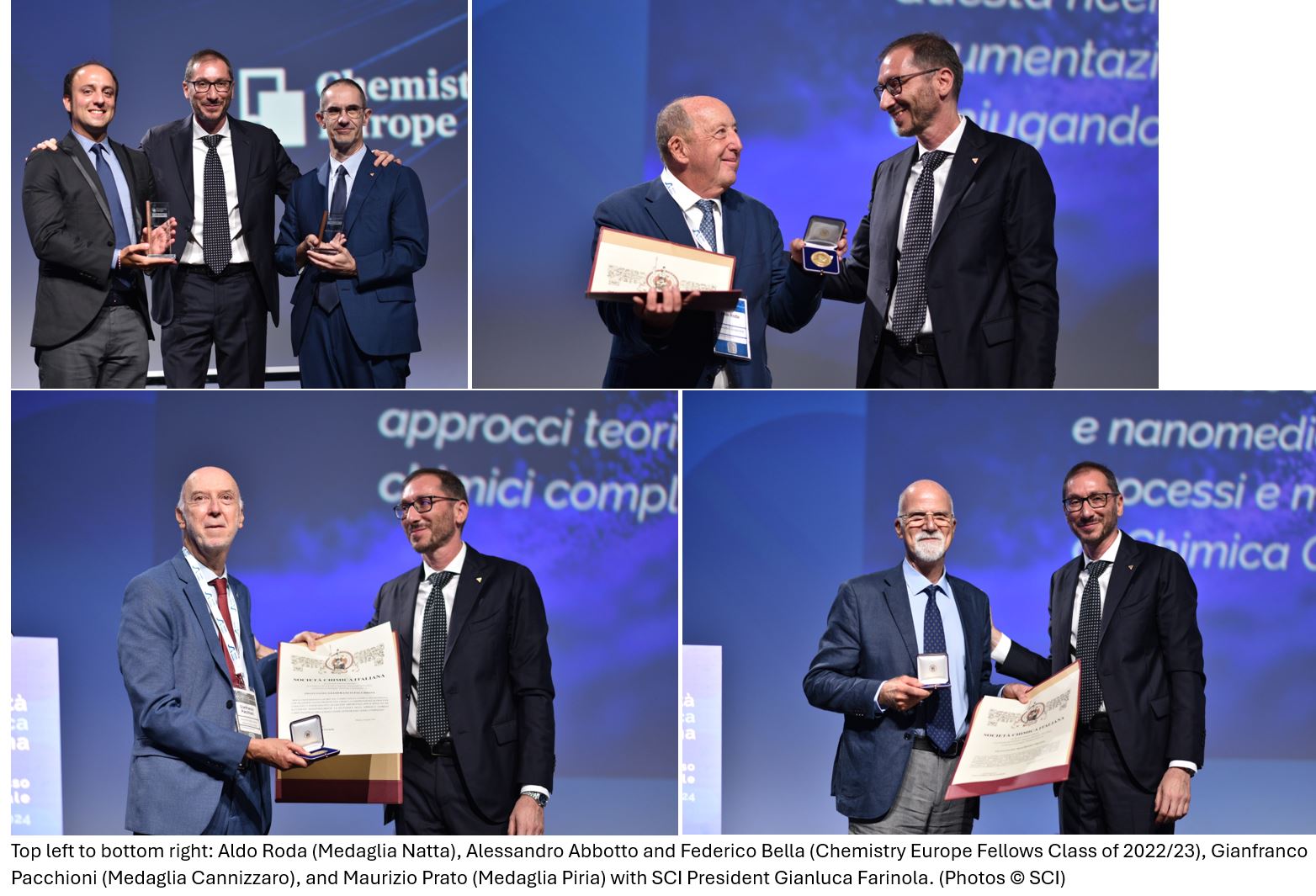
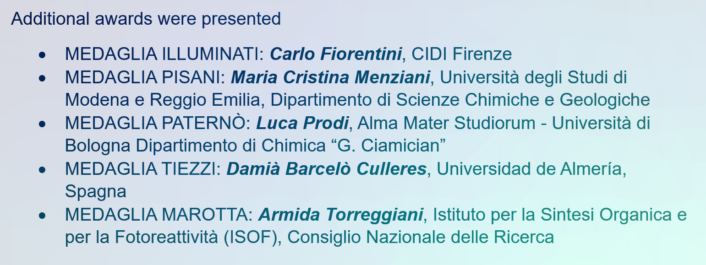
🧪 Selected TalksWhile in this article I focus mainly on the special events and presentations, there were also many scientific presentations. Here are three examples:
History of the Periodic TableThere have always been and continue to be efforts to represent the relationships among elements in various formats. Eric Scerri, Professor at the University of California, Los Angeles (UCLA), USA, provided a brief history of the periodic table’s origins and discussed the challenges it has encountered and continues to face today. In 1808–10, John Dalton (1766–1844) developed a method for determining provisional atomic weights based on stoichiometric measurements and logical inferences. Dalton’s atomic theory, which proposed that each element consists of unique atoms combining in fixed ratios, gained broad acceptance in the 1810s and 1820s. In 1829, Johann Wolfgang Döbereiner (1780–1849) made an early attempt to organize elements based on their physical properties by grouping some of them into triads, or groups of three. The atomic weight of the middle element was generally found to be the arithmetic mean of the atomic weights of the other two elements in the triad. These triads included chlorine, bromine, and iodine; calcium, strontium, and barium; sulfur, selenium, and tellurium; and lithium, sodium, and potassium. In 1860, at the first international chemistry conference, the Karlsruhe Conference, a scientific consensus was reached and a revised list of elements and atomic weights was adopted. This led to the independent discovery of more comprehensive periodic systems. Alexandre-Émile Béguyer de Chancourtois (1820–1886), John Alexander Reina Newlands (1837–1898), Gustavus Detlef Hinrichs (1836–1923), William Odling (1829–1921), Julius Lothar Meyer (1830–1895), and, finally, Dmitri Ivanovich Mendeleev (1834–1907) made important contributions, with Mendeleev’s periodic table of 1869 gaining prominence for its successful predictions of undiscovered elements. Eric Scerri described challenges that the periodic table faced, such as pair reversals and the discovery of noble gases. Discoveries in physics, including X-rays, radioactivity, and the electron, as well as quantum mechanics, led to a better understanding. However, there are still unresolved issues, such as the membership of group 3 in the periodic table and alternative representations like the 32-column format or the left-step periodic table. Some schemes include the first element of the lanthanide series, lanthanum (La), and actinides in Group 3, while others place these elements in separate groups or consider them part of a broader series due to their similar properties. In the 32-column format, the periodic table is expanded to include additional columns for the lanthanides and actinides, reflecting their properties and relationships more clearly. Charles Janet’s left-step periodic table organizes elements based on how electrons fill orbitals, rather than by valence, which refers to an electron’s bonding ability.
From Supramolecular Towards Adaptive ChemistryThe big question is: How does and did matter become complex, leading to beings that can question the universe’s origins. Jean-Marie Lehn, 1987 Nobel Prize Chemistry Laureate of the Université de Strasbourg, France, and a Chemistry Europe Fellow, started his talk with the Big Bang. While dark energy and dark matter make up 95% of the universe, only 5% is visible matter, which he calls “the matter that matters.” “We are part of this 5%”. Physical laws guide how this matter evolves chemically, creating increasing complexity from simple molecules to organized, living, and thinking beings. The driving force behind this is self-organization. Chemistry is the bridge between the laws of the universe (physics) and their expression in a highly complex feature (life/biology). Jean-Marie Lehn explained the evolution from molecular to supramolecular to adaptive chemistry as steps towards increasingly complex levels of matter. Adaptation and self-organization are intimately linked. Adaptation its the ability of a system to undergo self-organization towards another direction in response to external stimuli and environmental pressure [1]. The goal is to discover, understand, and implement the processes that govern the evolution of matter towards increasing complexity, from particles to thoughts. Jean-Marie Lehn defined the field of supramolecular chemistry and subsequently developed the field into new directions towards self-organization processes and adaptive chemistry. In the second part of his talk he gave examples on his research.
|
4 Welcome Reception & Conference Dinner
4.1 Dinner on the Lawn in the Footsteps of Sports and Music Legends
Vigorelli Stadium, built in 1935 and accommodating up to 9,000 people, is one of Italy’s most iconic sports venues. Renowned for its steep wooden track, it gained fame for hosting major cycling events, including Fausto Coppi’s world hour record in 1942. The stadium also hosted concerts, such as the Beatles’ first concert in Italy in 1965 and a legendary Led Zeppelin concert in 1971. Today, Velodromo Vigorelli is home to Milan’s American football teams.
For the dinner, tables with food and wine were set up on the turf under pavilions, creating a relaxed atmosphere and a great networking opportunity.
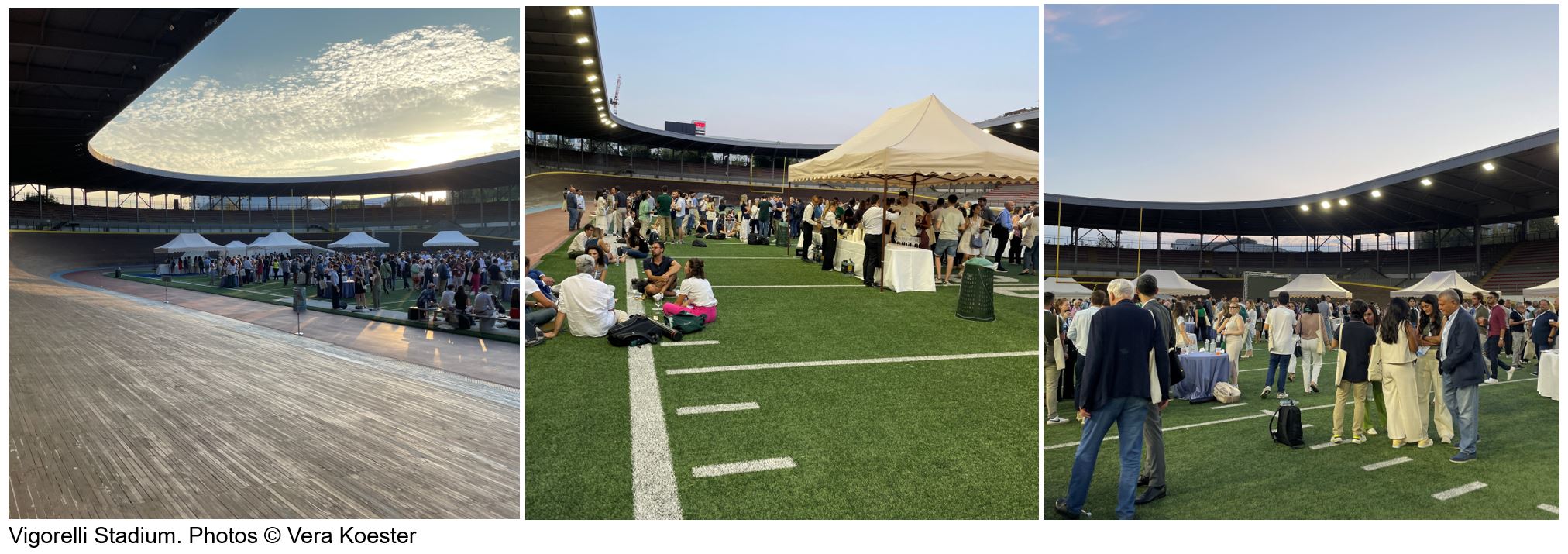
4.2 Dinner in the Midst of Leonardo’s Rich and Innovative Visions
The conference dinner was held at the Leonardo da Vinci Museum of Science and Technology, Italy’s largest science and technology museum, located in the ancient monastery of San Vittore al Corpo in Milan. The museum has various sections, including ones on space travel and shipping. The Leonardo da Vinci section shows, among other things, numerous reproductions of Leonardo’s machines based on his original drawings, including a hydraulic saw, a spinning machine, a flying machine, a double ballista, and Leonardo’s tank. Each of these exhibits includes the original drawing, the reconstructed machine, a video explaining its function, and a descriptive text.
Attendees had the opportunity to explore the museum before gathering for a reception in a courtyard. Following the reception, a grand dinner for the 800 guests took place in a large, beautifully reared and decorated historic hall, offering a stylish and ambient setting. The evening featured excellent food, engaging conversations, and a wonderful atmosphere for networking in a remarkable environment.
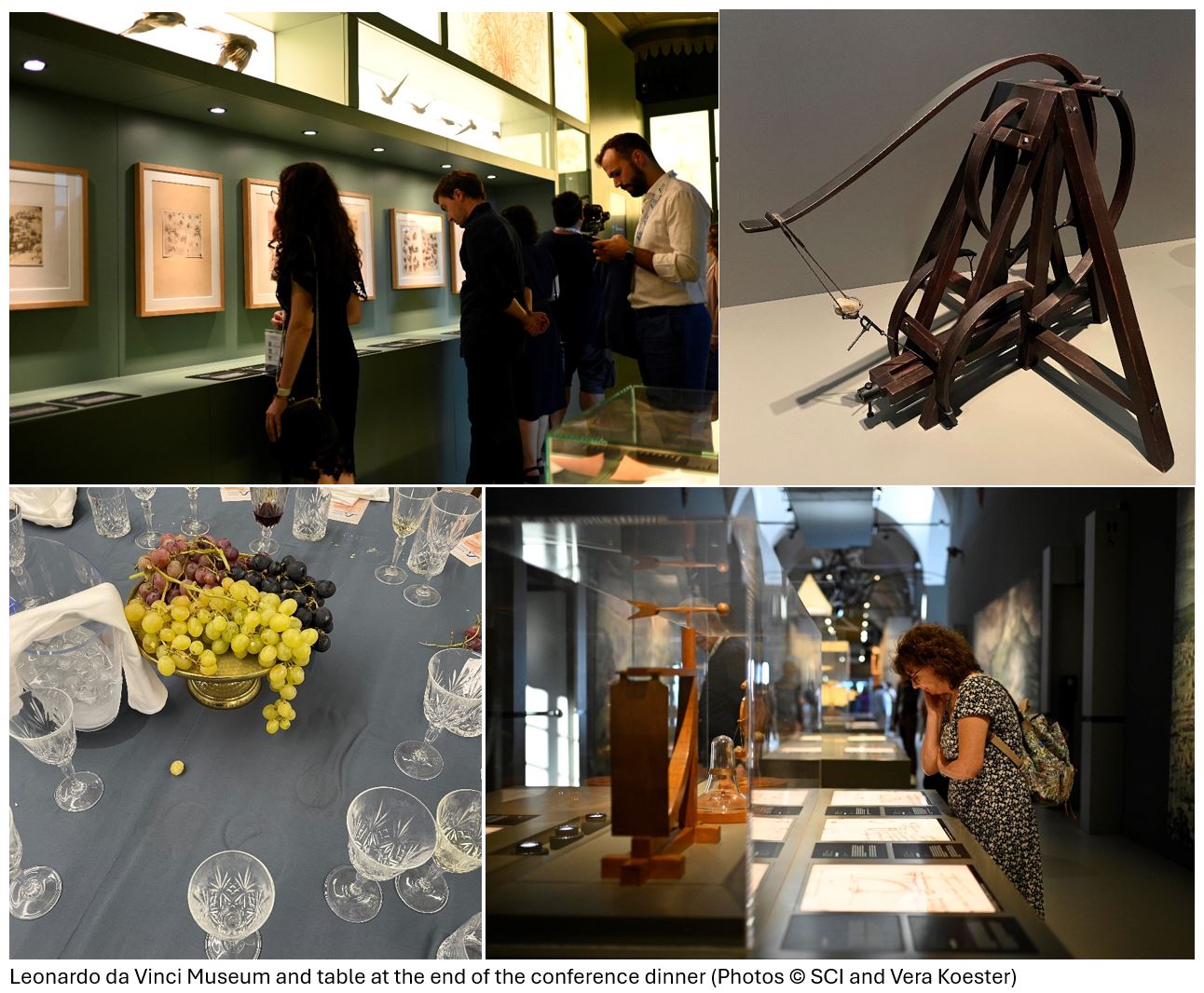
🎨 Exploring Fine Art with ChemistryHidden Stories of the Met’s ArtMarco Leona, Head of the Department of Scientific Research, Metropolitan Museum of Art (Met), New York, NY, USA, told the fascinating story of scientific research at the Met, which began in 1882 by crowdsourcing chemistry to confirm the authenticity of two marble sculptures that two Frenchmen claimed were forgeries. The campaign invited the public to “make the most careful examination” and allowed visitors to “cut, … scrape, … treat with chemicals, and examine under the microscope” the statues. The campaign fulfilled its purpose, but, of course, it did not go unnoticed by the objects themselves. In the 1920s and ’30s, the museum began a collaboration with Columbia University electrochemist Colin Fink, who pioneered metal analysis, conservation treatments, and preventive conservation research. At the same time, a young, refined, and tireless curator of medieval art, James Rorimer, who had studied chemistry at Harvard, began experimenting with ultraviolet light and flourescence. In this way, he made restorations and alterations and, in general, the invisible visible. For example, Marco Leona used the painting of Antoine Lavoisier and his wife Marie-Anne to show how the painting changed during the process of its creation as it adapted to the changing political situation. For example, large bookcases disappeared from the background, and Marie-Anne wore a large extravagant hat. Today, scientists at the Met are involved in all aspects of museum practice, from evaluating potential acquisitions to art historical studies, from research supporting conservation treatment to monitoring indoor air quality, from developing new analytical techniques to large-scale studies of artists’ materials and techniques. Chemistry is used to explore and tell the cultural, social, and technical stories behind the art and its creators, and to examine the significance and fragility of the objects. Raman and surface-enhanced Raman spectroscopy, X-ray fluorescence spectrometry and mapping, mineralogical and petrographic techniques, mass spectrometry, reflectance spectroscopy, and reflectance spectroscopy imaging are widely used.
Exploring Art Through Synchrotron X-RaysSince their discovery in 1895, X-rays have been widely used to analyze historical artifacts, with various techniques such as tomography, fluorescence, and diffraction providing complementary insights into an object’s structure and composition. In the past three decades, synchrotron-based X-ray techniques have enhanced heritage science by offering high beam intensity, nanometer-scale focus, and detailed chemical analysis at the sub-micrometric level. Marine Cotte, European Synchrotron Radiation Facility (ESRF), Grenoble, France, and Sorbonne Université, Paris, France, presented analyses carried out at the ESRF on major Italian artworks, including identifying different forms of lead white in Leonardo da Vinci’s Mona Lisa and The Last Supper. Chemistry records track original manufacturing processes as well as later degradation phenomena. To achieve good results, different techniques are often combined, as they offer various contrasts and information. In the early 16th century, many paintings were created on dark wooden panels. To enhance color vibrancy, artists commonly applied a thick white ground layer. Microsamples from Leonardo da Vinci’s Mona Lisa and The Last Supper were analyzed using synchrotron radiation high-angular resolution X-ray powder diffraction (SR-HR-XRPD), synchrotron radiation micro X-ray powder diffraction (SR-μ-XRPD), and micro Fourier transform infrared spectroscopy (μ-FTIR) to determine their compositions [2,3]. The ground layers contained saponified oil with high lead content, lead white pigment enriched with cerussite (PbCO3) and hydrocerussite (Pb3(CO3)2(OH)2), as well as some calcite (CaCO3) and a small amount of the rare plumbonacrite (Pb5(CO3)O(OH)2). Plumbonacrite is stable only under alkaline conditions, suggesting that this material was formed by a reaction between the oil and added lead(II) oxide (PbO). Leonardo probably tried to prepare a thick paint suitable for covering the wooden panel of the Mona Lisa by treating the oil with a high load PbO. In the samples from the The Last Supper, also PbO grains of orange litharge (α-PbO) and yellow massicot (β-PbO) were found in the primer and the overlying paint layer, formed at different temperatures. The mineral shannonite (Pb2OCO3) was also identified in the mural, potentially serving as an intermediate form in the formation of plumbonacrite from PbO [2,3]. Leonardo da Vinci’s use of a mixture of lead white and oil for the ground layers of the Mona Lisa and The Last Supper was innovative for its time, possibly experimental. The discovery of lead-based compounds such as PbO, shannonite, and plumbonacrite suggests that Leonardo intended to create a fast-drying preparatory layer, although the formation of these compounds was likely an unintended result of the alkaline conditions. This discovery inspires further analysis of similar materials in other Renaissance artworks to understand the underlying chemical processes and their impact on paint properties.
|
5 Closing Remarks
It was a remarkable, multifaceted, and well-organized event, leaving me with much to reflect upon and inspiring new ideas. I am impressed by how large the Italian community is and I did not expect to attend a national meeting with well over 2,000 participants, which is about half of the SCI’s membership.
Maurizio Benaglia, Professor at the University of Milan and a member of the Organizing Committee, told me that “the conference gave the entire community of Italian chemists the opportunity to meet after seven years.” He continued that he was particularly impressed by the strong participation of the 1,200 young researchers, who consistently attended sessions over the five days, engaging not only with cutting-edge research topics but also with environmental issues, cultural heritage, science communication, and special events like the career session.
Alessandro Abbotto, Professor at the University of Milano-Bicocca and a member of the Organizing Committee, was also impressed by the large turnout of young chemists: “This conference was marked by numerous innovations, but perhaps the most significant was the strong participation of young people—about 1,200 attendees, representing 50% of the total—nearly all of whom received scholarships that fully covered the registration fee.” He continued, emphasizing the importance of involving and inspiring the young because they are the future.
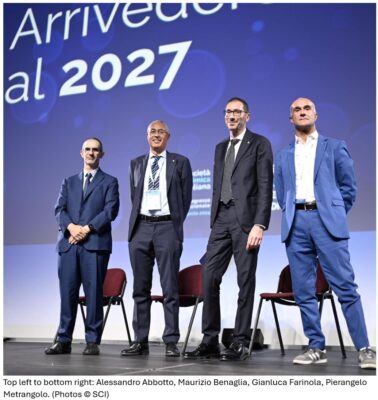 Pierangelo Metrangolo, Professor at Politecnico di Milano and a member of the Organizing Committee, added that “SCI 2024 was unique for several reasons: its 2,400 registered participants, the 50 companies in the exhibition, the 1,135 free registrations for attendees under 35, and a program featuring outreach activities like art and music intersecting with chemistry.” He continues: “I particularly appreciated the Tuesday sessions on “Chemistry and Society” and “Industry Focus.” Both sessions emphasized how chemistry may address the issues that Europe is currently facing, such as raw materials shortage, as well as the big global challenges such as the climate crisis, environmental protection, and energy transitions. Sustainability, circular economy, and life cycle assessment are the key themes that all companies are focusing on.”
Pierangelo Metrangolo, Professor at Politecnico di Milano and a member of the Organizing Committee, added that “SCI 2024 was unique for several reasons: its 2,400 registered participants, the 50 companies in the exhibition, the 1,135 free registrations for attendees under 35, and a program featuring outreach activities like art and music intersecting with chemistry.” He continues: “I particularly appreciated the Tuesday sessions on “Chemistry and Society” and “Industry Focus.” Both sessions emphasized how chemistry may address the issues that Europe is currently facing, such as raw materials shortage, as well as the big global challenges such as the climate crisis, environmental protection, and energy transitions. Sustainability, circular economy, and life cycle assessment are the key themes that all companies are focusing on.”
Maurizio Benaglia agrees that the event “also served as a great opportunity to communicate to civil society the central role that chemistry can and intends to play in achieving sustainable development and transitioning towards a circular economy”.
Overall, the atmosphere was great during these five rich and fully packed days, and it was a bit hard to leave. And, next time, I hope to see more of Milan …
In his closing words, Gianluca Farinola said: “Conferences like this one create a community that lives together an experience for one week, and then it leaves. However, the community has shared an important experience that will last long and will keep it alive at a distance, having shared common directions for future developments: communication, transdisciplinarity, social and cultural engagement, support for young people, development of new languages through hybridization with other fields, ethics in science. This is how we value our role and we see our future.”
References
[1] Jean-Marie Lehn, Perspectives in Chemistry—Steps towards Complex Matter, Angew. Chem. Int. Ed. 2013. https://doi.org/10.1002/anie.201208397
[2] Unusual Lead-Based Minerals in Artworks by Leonardo da Vinci, ChemistryViews 2023.
[3] Victor Gonzalez, Gilles Wallez, Elisabeth Ravaud, Myriam Eveno, Ida Fazlic, Tiphaine Fabris, Austin Nevin, Thomas Calligaro, Michel Menu, Vincent Delieuvin, Marine Cotte, X-ray and Infrared Microanalyses of Mona Lisa’s Ground Layer and Significance Regarding Leonardo da Vinci’s Palette, J. Am. Chem. Soc. 2023. https://doi.org/10.1021/jacs.3c07000
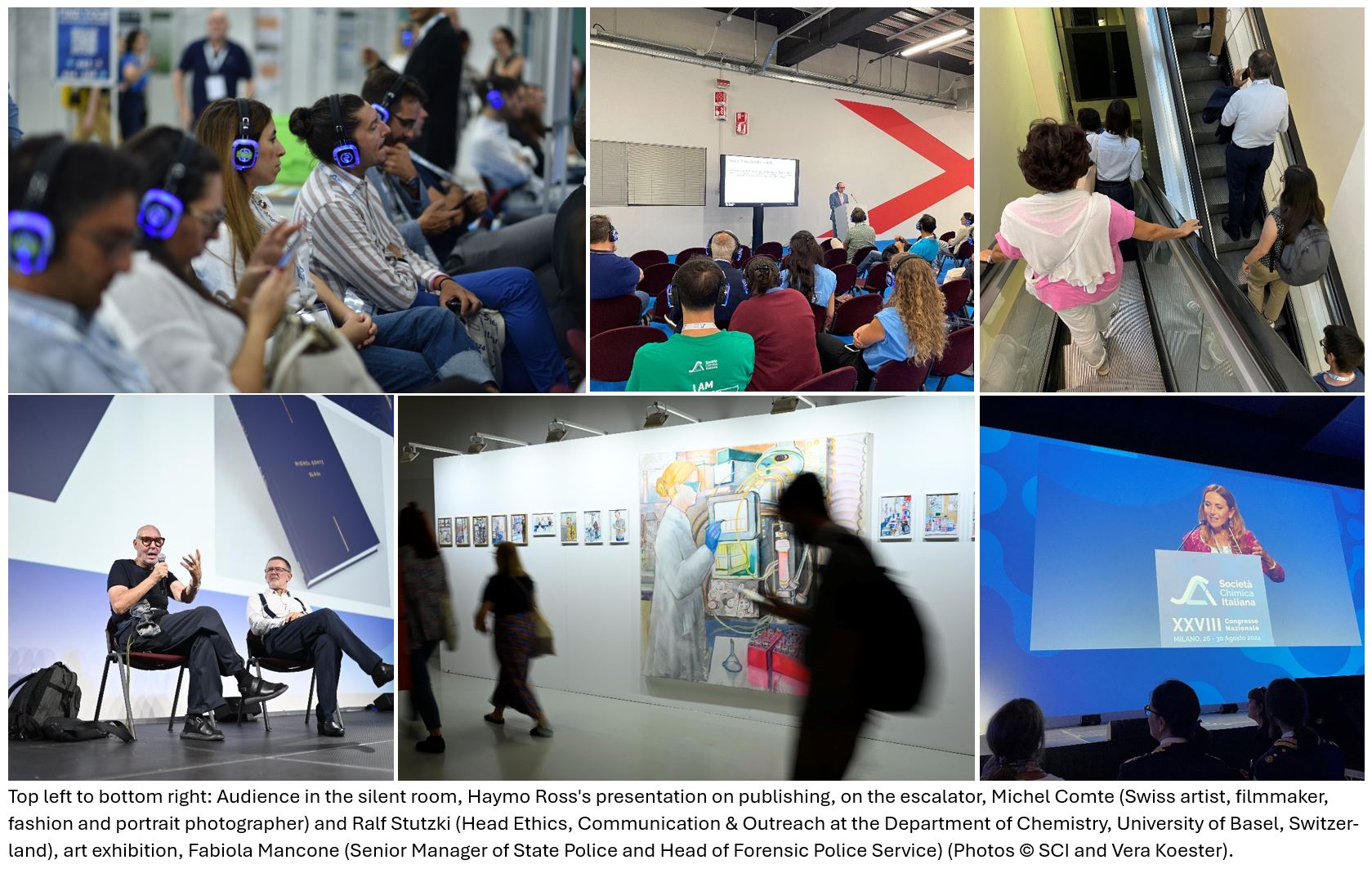
Also of Interest
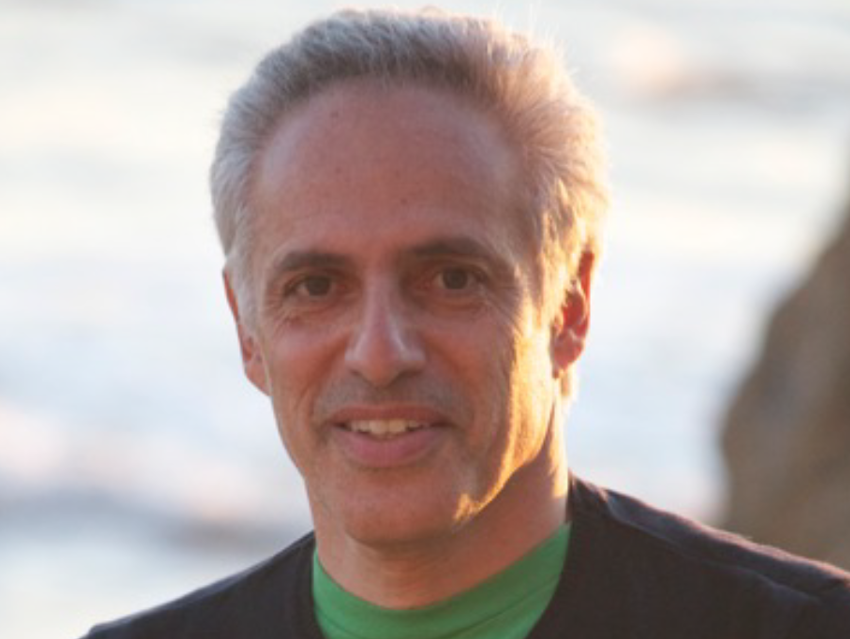
Interview with E. Scerri about his fascination for the periodic system, how discoveries are made, and what makes Mendeleev unique

The General Assembly of Members nominated Professor Francesco De Angelis as an Honorary Member of the Italian Chemical Society (SCI)

Compilation of statements by Presidents of chemical societies (ACS, GÖCH, RACI, RSC, SCI) on the GDCh’s motto “Rethinking Chemistry”

A compilation of articles on chemistry in artworks and music, on art inspired by chemistry, about the work of scientific teams in museums

A compilation of articles on chemistry in the movies
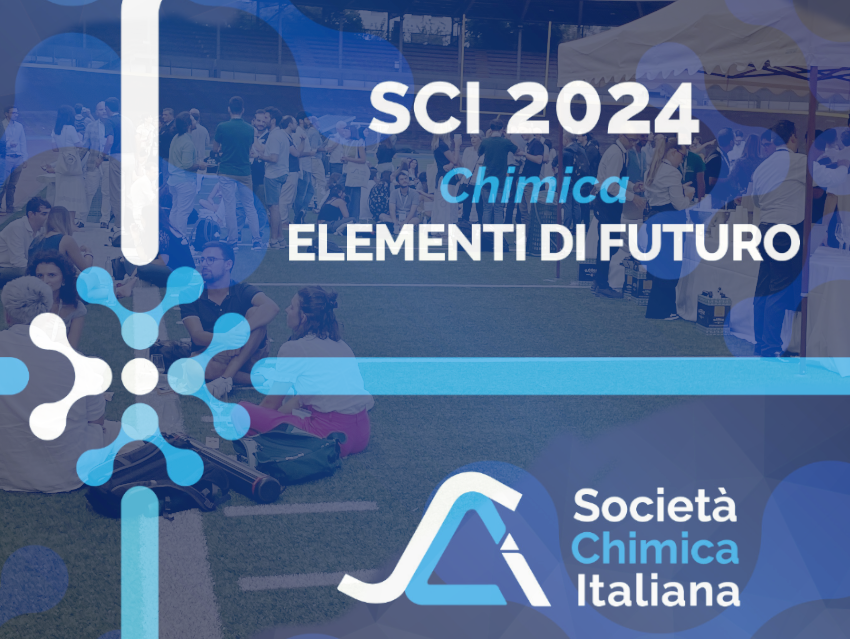
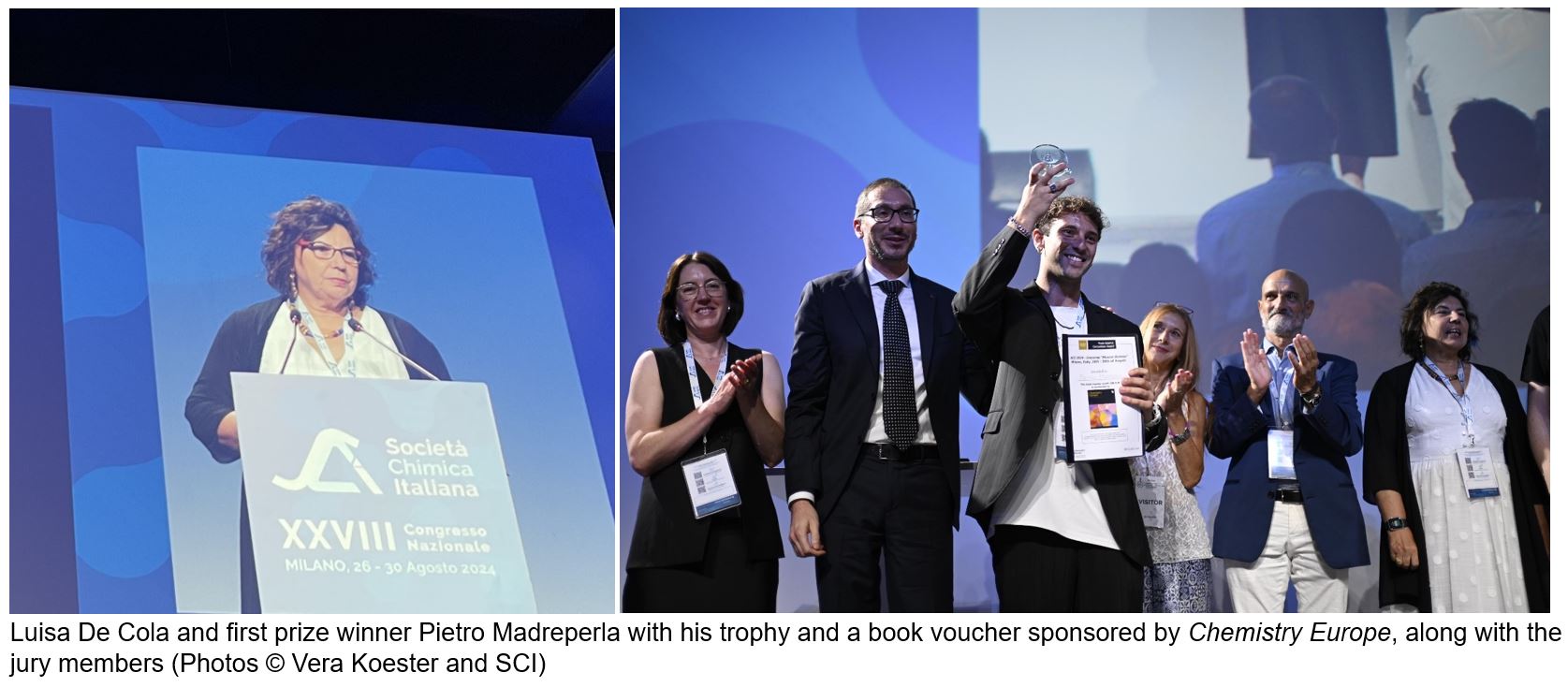
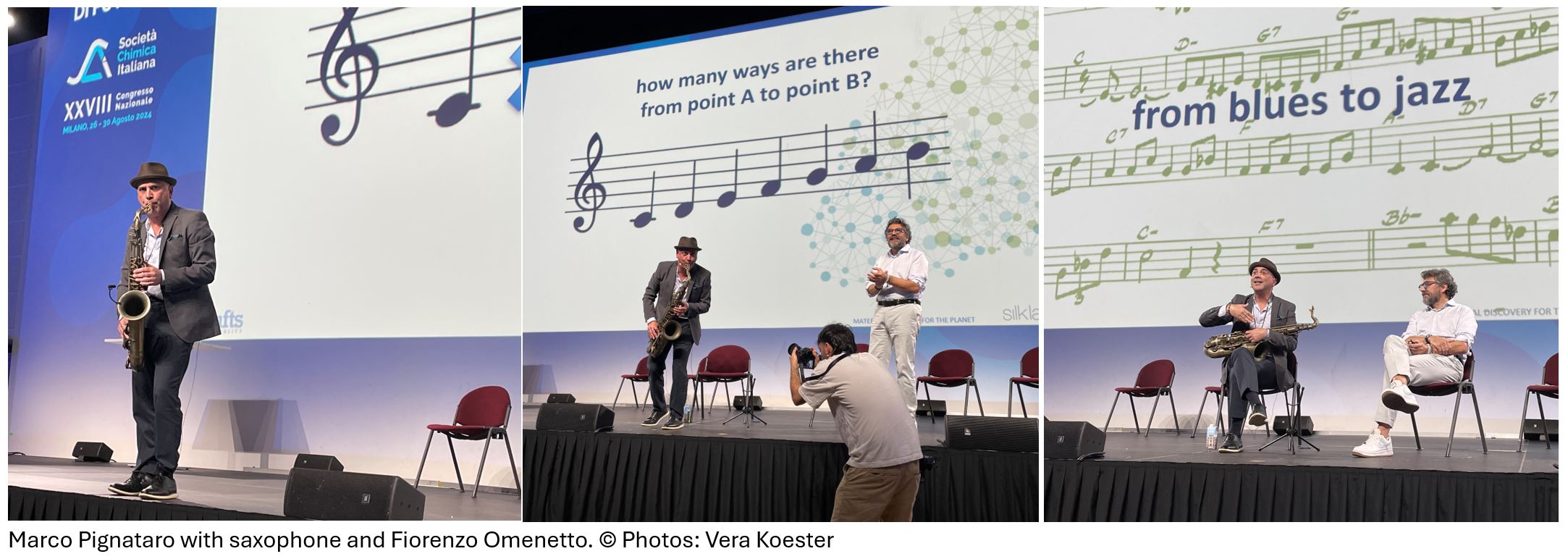
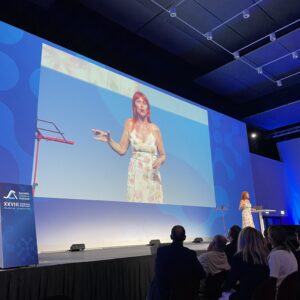 In well-researched monologues, Gabriella Greison explores extraordinary historic scientists who changed the world from an original and surprising perspective, restoring both their voices and their humanity. At the conference, she presented a performance about six women in chemistry or heroines of science. The narrative theater presentation followed a historical lecture on these women by Margherita Venturi, Università di Bologna.
In well-researched monologues, Gabriella Greison explores extraordinary historic scientists who changed the world from an original and surprising perspective, restoring both their voices and their humanity. At the conference, she presented a performance about six women in chemistry or heroines of science. The narrative theater presentation followed a historical lecture on these women by Margherita Venturi, Università di Bologna.